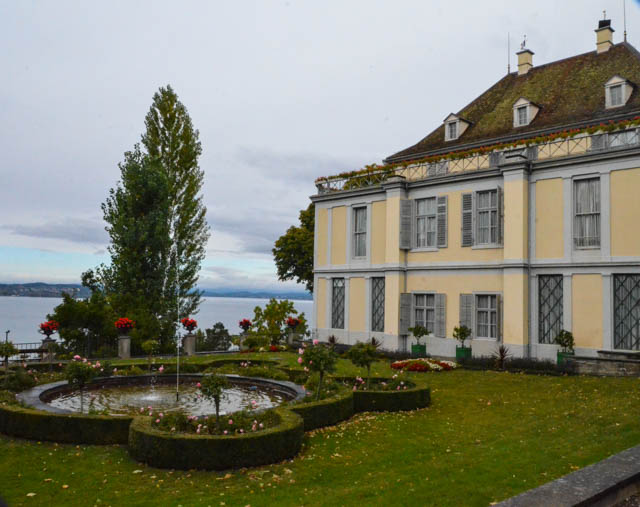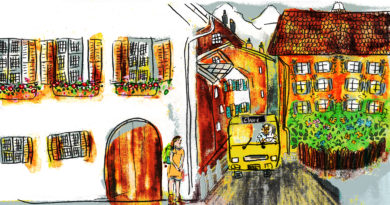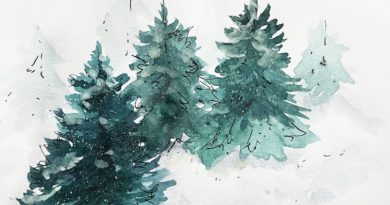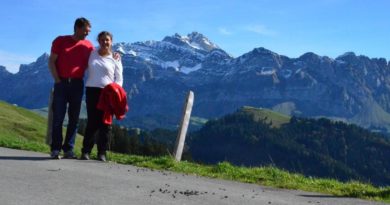Napoleon Museum and Arenenberg
 As the autumn leaves begin to cascade from the trees, my mood seems to fall as well. We all face life’s challenges from time to time, and this is one that creeps up on me each year – the winter blues. (I am not alone; 10 to 20 percent of people suffer from the winter blues.) To combat this mood change I greatly increase both my time spent outside – in the daylight if possible – and with my family and friends. Instead of following my fall instincts to curl up with a book, I head out to walk. Switzerland is the ideal place for walking, but what about inclement weather? This past Sunday, our family hiked in the vineyards and gardens of Arenenberg, and as the weather turned stormy we took a detour away from the vineyards and visited the Napoleon Museum in Salenstein, Thurgau. This is the perfect outing for a fall day, and it certainly lifted my spirits!
As the autumn leaves begin to cascade from the trees, my mood seems to fall as well. We all face life’s challenges from time to time, and this is one that creeps up on me each year – the winter blues. (I am not alone; 10 to 20 percent of people suffer from the winter blues.) To combat this mood change I greatly increase both my time spent outside – in the daylight if possible – and with my family and friends. Instead of following my fall instincts to curl up with a book, I head out to walk. Switzerland is the ideal place for walking, but what about inclement weather? This past Sunday, our family hiked in the vineyards and gardens of Arenenberg, and as the weather turned stormy we took a detour away from the vineyards and visited the Napoleon Museum in Salenstein, Thurgau. This is the perfect outing for a fall day, and it certainly lifted my spirits!
Located in Salenstein, canton Thurgau, on the east-west axis of Arenenberg overlooking Lake Constance, the Napoleon Museum and gardens is a gothic period house that was once the home of one of my favorite figures in history – the tragic Hortense de Beauharnais, queen consort of Holland from 1806-1810 and mother of Napoleon III, emperor of France. She was the daughter of Josephine Beauharnais (former empress of France), and following her mother’s union with Napoleon Bonaparte, Hortense became his stepdaughter. She was coerced into marrying Napoleon’s brother, Louis Bonaparte; and she endured an unhappy marriage, an infamous lover, and she had an illegitimate child. I suppose you could say that her life was most definitely full of challenges!
Most people are aware of Hortense’s stepfather’s fate, if not from history class then from the ABBA pop song “Waterloo.” In reality, and in the song, Napoleon lost the battle at Waterloo and was exiled to the island of Elba. Unfortunately, Hortense’s own fate was tied to that of Napoleon’s and she, too, was exiled. She lost her title as consort queen of Holland and fled France in 1815, travelling through Lausanne, Zurich, and Frauenfeld to Constance, Germany. She did, however, maintain allies and friends, whom she successfully cultivated and activated.
The canton of Thurgau in Switzerland allowed Hortense to purchase the dilapidated palace on Arenenberg. She seized the opportunity and ordered major renovations of the villa, removing towers, adding a pavilion construct on the south-end of the villa, and erecting a chapel. The architectural changes, which still exist today, were completed in 1818 and Hortense moved in. Fortunately for us, Hortense attempted to recreate the Chateau de Malmaison, the final home of Napoleon I and Hortense’s mother, Josephine Beauharnais, in France. The beautiful palatial home in Arenenberg that houses the Napoleon Museum is decorated in a style believed to replicate Hortense’s (and later, her daughter-in-law Eugenie’s) renovations. As you enter the foyer, you see a carpeted spiral staircase leading up to the sleeping rooms and, on the top floor, the former servants’ rooms. You must don felt slippers over your shoes in order to walk through the elaborate rooms; my kids have always enjoyed doing that. Their favorite room is located on the ground floor to the left of the entrance; it is decorated and refurbished as if it were the grand military tent of Napoleon himself.
Of course, there are ample portraits of famous family members and victorious war scenes, as well as landscape paintings. I particularly enjoy viewing the likenesses of Hortense herself and Eugenie, her future daughter-n-law. Walking around in the museum, my youngest son said that he had the feeling that he was walking not only within a grand house but also among greatness. I had to agree with him. You almost expect to meet Hortense and her son Napoleon III, who is said to have planned his takeover of France from within the rooms of the current museum.
In addition to the main house, the large so-called prince’s wing is located next to the main house. This building contained the former kitchen and imperial bathroom, and the male members of the family are said to have slept there. Currently a seminar and event hotel as well as a restaurant belonging to the education and consultant center of the Canton of Thurgau and museum gift shop are situated within this building. If you have time and the weather permits, you should enjoy the vast gardens and walk through the adjacent vineyards.
The gift shop is also worth a visit. It carries a wide array of topical books for children and adults, memorabilia, and other interesting objects. Our youngest son purchased a glass calligraphy pen with red ink, which functions beautifully. The shop also sells some interesting local wines, with appellations like Hortense Cuvée Blanc, Eugenie Blanc de Noir, Bonaparte Cuvée Rouge, and our favorite – the Arenenberger Müller-Thurgau. They are produced from the grapes in the three hectares of vineyards that surround the museum and gardens. The wines can be purchased over the Internet.
There are so many interesting facts about the house and lives of the former inhabitants that, if you can, I would suggest taking a guided tour of the museum. This is inexpensive and available every Sunday in German. If your German skills are not up to snuff, you can also reserve a tour in English for groups of 10 for CHF 140.00. We have taken this tour several times. Each time we learn a great deal of information including, much to my children’s delight, scandal about the former French royals who lived in the Canton of Thurgau. It is pleasant to hear how they dealt with life’s challenges!
Do check the museum website before visiting, because occasional special events like a children’s day or an English Christmas celebration have been conducted in the past and are definitely worth experiencing. Furthermore, traditional carriage rides are available on some days.
Museum opening days/times in fall and winter:
From October 19, 2015 to March 20, 2016, Tuesday through Sunday, 10:00-17:00. The museum is closed from 24 December 2015 to 1 February 2016. See the website for opening days/times from March to October and for the various admission prices.
There are public guided tours through the museum (in German) every Sunday at 14:00, through December 20, 2015. Duration: 50 minutes, price: SFr. 18.
Further reading: There is an interesting website about Arenenberg from the community of Salenstein (in German).
By Teresa Bingham Miller
Teresa is an earth scientist and instructor by education and an avid traveler and adventurer by nature. She has three boys ages 32, 19 and 16.




